At a glance
Expert’s Rating
Pros
- Big, immersive, yet detailed and subtle sound
- Syncs its audio with Samsung TVs
- SpaceFit Sound room correction
- AirPlay 2 and Spotify Connect support
Cons
- No discrete volume for built-in Alexa
- Power cords for satellite speakers are too short
- Q-Symphony and wireless Dolby Atmos require a Samsung TV
- No Chromecast support
Our Verdict
The HW-Q990C doesn’t offer many improvements over Samsung’s recent flagship soundbars, but it still delivers stellar audio performance and a bevy of features, particularly for Samsung TV owners.
Price When Reviewed
$1,899.99
Best Prices Today: Samsung HW-Q990C
$1297.99
$1,597.99

$1597.99

$1599.99

$1709
$1899.99
Samsung has wisely chosen to stay the course with the HW-Q990C, the latest version of its flagship 11.1.4-channel soundbar. Delivering big, bold, yet refined sound, the HW-Q990C boasts a no-fuss setup process (well, short power cords notwithstanding), Dolby Atmos and DTS:X support, automatic room correction, and a couple of bonuses for Samsung TV owners, including wireless Atmos connectivity and Q-Symphony, a feature that syncs the soundbar’s audio with the TV’s speakers.
So, what’s changed on the HW-Q990C since last year’s HW-Q990B? Not much, honestly. Q-Symphony has received some upgrades, as has SpaceFit Sound room correction, while the Adaptive Sound 2.0 mode is said to perform better at lower volumes. Otherwise, this is largely the same soundbar, right down to the mostly aluminum design aesthetic, the terrific audio performance, and even the svelte remote.
If you already own the Samsung HW-Q990B (or even the HW-Q950A from 2021), I don’t see any pressing need to upgrade to the new HW-Q990C; indeed, if you spot a good deal on last year’s flagship, you might want to grab that model instead. Also, those without a Samsung TV might balk at paying top dollar for a soundbar with signature features that depend on a Samsung set.
That said, the Samsung HW-Q990C does churn out tremendous sound even without a Sammy TV (I tested it without one). Given the quality and maturity of this flagship model, I’d consider the hefty $1,899.99 price tag (which is currently getting a steep discount) a worthy investment.
Design & build
- Perforated aluminum chassis
- 11.1.4 channels
- 22 drivers
The Samsung HW-Q990C looks practically identical to its predecessor, last year’s HW-Q990B, with the hefty main soundbar unit arriving with the same measurements (48.5 x 2.7 x 5.4 inches, WxHxD) and weight (17 pounds).
The Samsung HW-Q990C hits the sweet spot among the current crop of high-end soundbars, delivering pleasing and immersive sound, easy setup, AirPlay 2, and room calibration.
The soundbar has a perforated aluminum chassis, with angled left and right end caps that allow the side-firing drivers to bounce audio in different directions around the room. The twin wireless satellite speakers have a similar design, complete with a slightly vaulted top, while the bulky subwoofer (8.7 x 16.3 x 16.1 inches, WxHxD) has an “acoustic lens” design that boosts its bass response, according to Samsung.
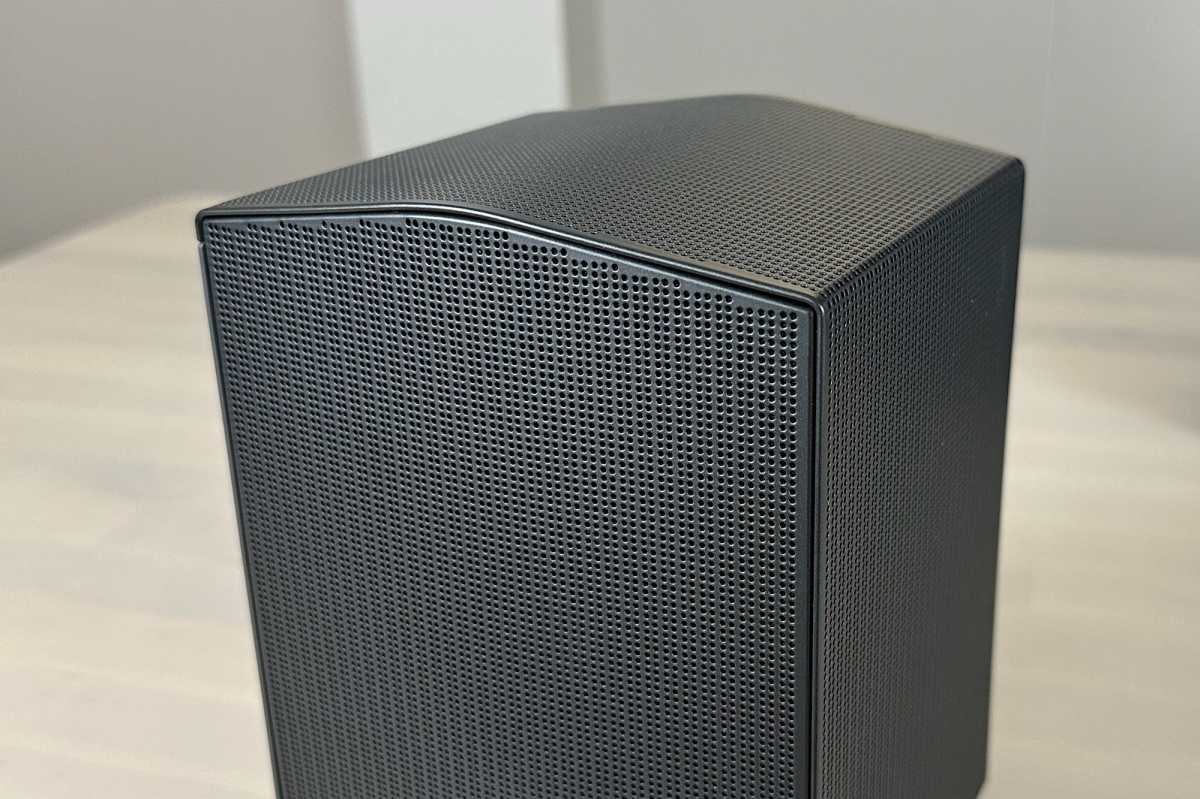
The tops of the HW-Q990C’s satellite speakers are slightly vaulted, just like last year’s model.
Ben Patterson/Foundry
All told, the HW-Q990C packs 22 drivers, including 15 in the main soundbar unit, 3 apiece in the satellites, and the woofer in the sub. The main unit’s 15 drivers include upfiring left and right cones; forward-firing drivers for the left, right, and center channels; and angled surround channels at the ends, while the satellite speakers have front-, side-, and up-firing drivers. That all adds up to an 11.1.4-channel configuration, including four height channels for immersive Dolby Atmos and DTS:X soundtracks.
This review is part of TechHive’s in-depth coverage of the best soundbars.
It’s worth noting that besides being positioned behind your sofa, the two wireless satellite speakers can be placed in the front of the room, flanking the soundbar and thus bolstering the front and height left and right channels. It’s a configuration you should probably skip unless there’s absolutely no room in your listening area for rear speakers, but the option is there if you need it.
Sitting on top of the soundbar are four clickable buttons, including a multi-function button (that powers on the soundbar and wakes built-in Alexa, which we’ll discuss in a moment), volume up and down buttons, and a mic mute button. Meanwhile, the remote features easy-to-find rockers for the main and subwoofer volume, along with a five-way navigation pad for controlling media and buttons for trimming channel levels, switching sound modes, and dipping into the soundbar’s various settings.
Besides the remote, you can also control the HW-Q990C from the Samsung SmartThings app, which you’ll need to connect the soundbar to your home Wi-Fi router. Once connected, the SmartThings app will let you place the HW-Q990C in a “room” in your home, alongside your other SmartThings-connected devices
The HW-Q990C’s LED display peeks out from behind the chassis’s perforations on the right end of the unit, offering details on volume level, the currently selected inputs, audio formats, and the like. By default, the display quickly goes dark after a brief period of inactivity, so I never found it distracting.
Connectivity
- HDMI-eARC and 2x HDMI inputs
- Wireless Dolby Atmos
- AirPlay 2, Spotify Connect, Tidal Connect
- Bluetooth
Hidden somewhat awkwardly on the bottom of the HW-990C (its predecessor had the same design) are the soundbar’s various input and output connectors. Most users will opt for the HDMI-eARC port, which allows a TV to pipe audio (including lossless Dolby TrueHD and DTS-HD Master Audio tracks) to the soundbar from any of the TV inputs, but there are also a couple of HDMI inputs for those who’d rather connect video sources directly to the soundbar. For the latter scenario, keep in mind that the HW-Q990C (like other Samsung soundbars) supports 4K HDR10+ but not Dolby Vision passthrough.
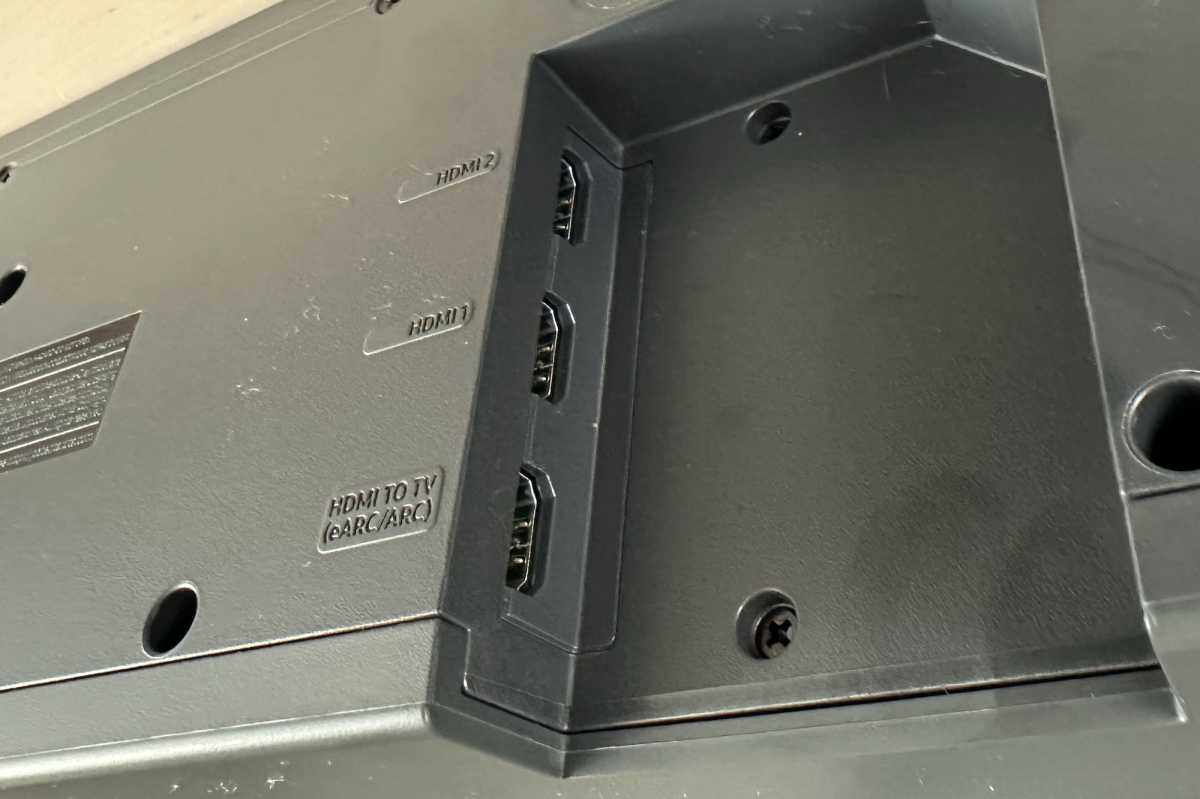
The HW-Q990C has one HDMI-eARC interface and two HDMI inputs.
Ben Patterson/Foundry
There are also a couple of ways to wirelessly connect your TV to the HW-990C, but only if you have a Samsung TV. The first is via Bluetooth, which delivers stereo audio to the soundbar (the 2-channel sound can later be upmixed all the way to 11.1.4), and the second allows for wireless Dolby Atmos, a feature introduced with last year’s HW-Q990B. Wireless Dolby Atmos is a rarity as far as soundbars are concerned, and while LG’s flagship soundbar can do Atmos without wires too, doing so requires an optional dongle. (Then again, LG’s dongle can be used with third-party TVs.)
Wireless casting support for the HW-990C includes Apple’s AirPlay 2, allowing the soundbar to join AirPlay speaker groups, along with Spotify Connect and Tidal Connect. There’s no Chromecast support, but Android users can always stream tunes to the soundbar via Bluetooth.
Finally, there’s an optical (Toslink) input that lets you connect the HW-990C to legacy TVs, while the USB-A port is only for installing firmware updates.
Setup
- Wall mounting hardware included
- Easy Wi-Fi connection via SmartThings
- Satellite speaker power cords are too short
The easiest way to install the Samsung HW-Q990C in your living room is by placing it in front of your TV. Given that the soundbar is only 2.7 inches high, it likely won’t block the bottom of your TV (it does graze the eye line to the bottom of my low-slung LG C9, but not distractingly so). Another option is to mount the soundbar on the wall under your TV, and Samsung provides mounting brackets, a screw kit, and a wall mount guide for this purpose.
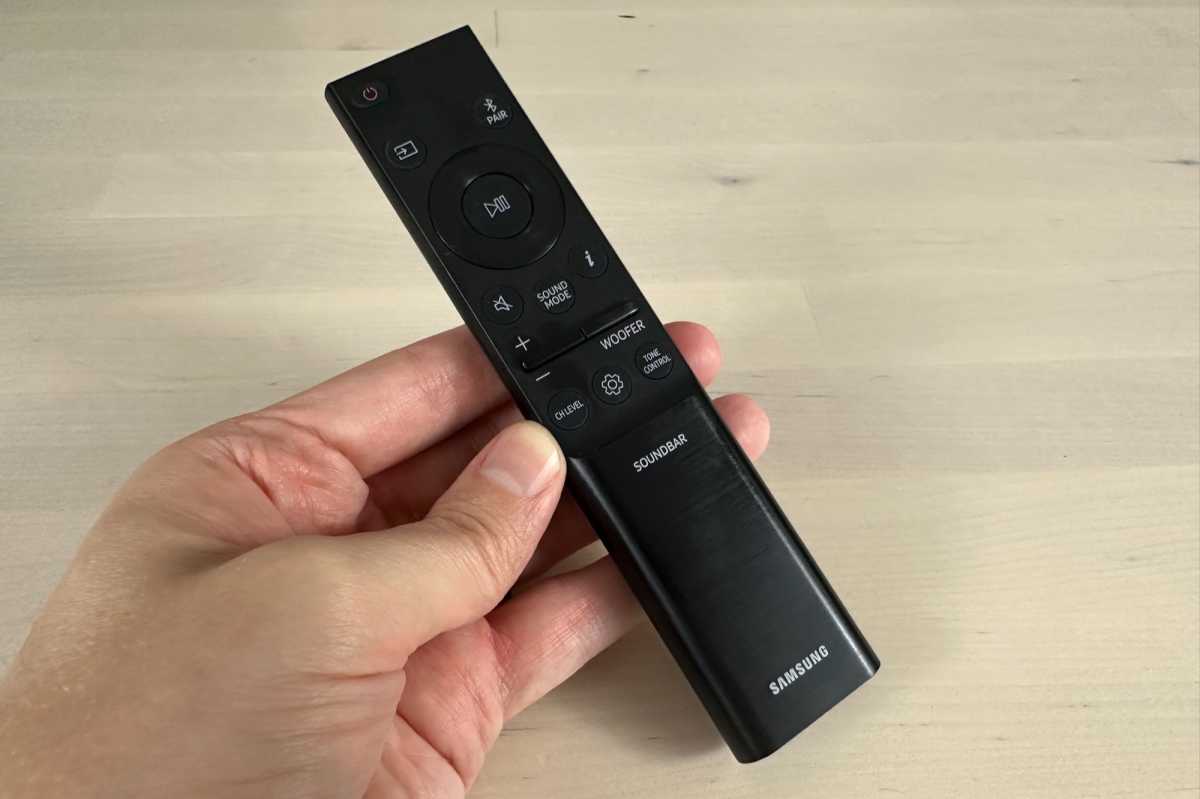
Remember the remote bundled with last year’s HW-Q990B? The new HW-Q990B soundbar comes with the exact same remote.
Ben Patterson/Foundry
The main soundbar unit, the subwoofer, and each of the satellite speakers come with their own power cords; plug them in, and the speakers should (and did, in my case) connect to each other automatically. One annoying setup quirk is that the power cords are each just five feet long–not a big problem for the soundbar itself and the subwoofer, but restrictive when it comes to placing the surround speakers. My advice: Grab a couple of extension cords (just make sure they accommodate three-prong plugs).
As I mentioned before, you connect the HW-Q990C to Wi-Fi using the Samsung SmartThings app. I’ve had headaches connecting other soundbars to my home Wi-Fi router in the past, but the connection process with the SmartThings app was a snap.
Smart features
- Q-Symphony
- SpaceFit Sound Pro
- Built-in Alexa
- Adaptive Sound
Q-Symphony is Samsung’s signature soundbar audio trick, allowing its higher-end Q-series soundbars (such as the one we’re reviewing here) to sync with the speakers on similarly high-end Samsung TVs. Last year’s Q-Symphony 2.0 added the ability to sync its soundbars with all the drivers on a Samsung TV rather than just some of them. For this year’s Q-Symphony 3.0, the technology now leverages the Neo Quantum Processors in the latest Samsung sets to pull out dialogue audio and pipe it through the soundar’s drivers, while surround audio goes to the TV speakers.
Sounds pretty cool (Samsung says the updated Q-Symphony delivers “more detailed and three-dimensional sound”), but you need a Samsung TV to use it–and alas, I was using an LG C9 OLED for my testing. As you’ll read later, I don’t believe Q-Symphony is essential for teasing out excellent audio from the HW-Q990C, but if you don’t have the right Samsung TV to pair with the soundbar, you’re not getting the full bang for your buck.
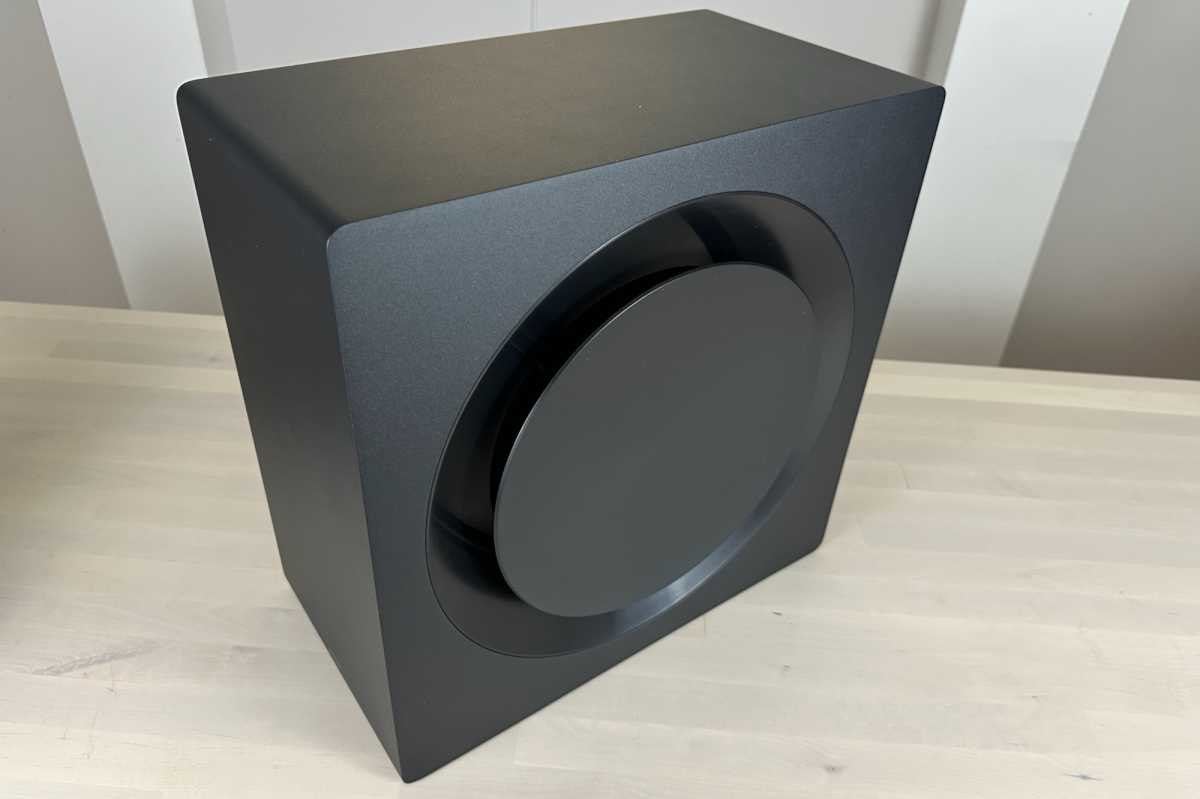
In a design touch carried over from the previous model, the HW-Q990C’s subwoofer has an “acoustic lens” that helps accentuate bass response.
Ben Patterson/Foundry
Another new feature that works without a Samsung TV is SpaceFit Sound Pro, a room calibration feature that’s been updated to analyze lower audio frequencies rather than simply focussing on surround effects. SpaceFit Sound Pro works continuously in the background, using the soundbar’s built-in microphone to adjust the audio on the fly according to your room’s acoustics. It’s an easy set-it-and-forget-it feature, but likely won’t be as precise as the more time-consuming method employed by many AV receivers, which involves placing a mic in multiple listening positions.
Then there’s Adaptive Sound, a sound mode that tweaks the HW-Q990C’s audio depending on what’s playing. In my experience with previous Samsung soundbars, Adaptive Sound did an impressive job of optimizing the soundbar’s audio across a variety of content, from big Dolby Atmos soundtracks to 2.0-channel dramas. This year’s Adaptive Sound 2.0 is billed at being better at tweaking the audio at lower volumes.
Yet another smart audio feature is Active Voice Amplifier, which detects and amplifies the dialog in the audio. It’s a handy feature for anyone who’s frustrated by poorly mixed sound that emphasizes the music and explosions while shunting dialogue into the background, but it runs the risk of pushing the voices a little too hard at higher volumes. Luckily, you can toggle the feature from the remote or the Samsung SmartThings app.

Four buttons are on the top of the Samsung HW-Q990C: one for multifunction, two for volume, and one for mic mute.
Ben Patterson/Foundry
Finally, the HW-Q990C offers built-in Alexa, which essentially turns the soundbar into a smart speaker. While it may seem convenient to chat with Alexa directly from the soundbar, I was annoyed that the volume of Alexa’s voice is tied to the main speaker volume, which means Alexa will shout at you if you have the soundbar’s volume dialed to an even moderate level. This has been a problem with all of Samsung’s previous soundbars with built-in Alexa (the issue isn’t isolated to Samsung, either), and after being jolted by Alexa’s loud chatter too many times, I turned the feature off.
Performance
- Clear, detailed, naturalistic sound
- Terrific Dolby Atmos effects
- Deep but controlled bass
- Subtle music performance
I’ve been very impressed by the audio performance of Samsung’s top-of-the-line soundbars in the past, using words like “terrific,” “thrilling,” “immersive,” and “pulse-pounding” to describe their sound. I’ll be reaching for many of the same adjectives as I describe the sonic performance of the HW-Q990C.
First, I should note that I conducted most of my tests using Samsung’s Adaptive Sound mode, which (as I’ve found in the past) was more than adequate for handling a wide range of content on the soundbar. The Surround and Game Pro modes were fine too, but keeping Adaptive selected meant that I didn’t have to swap sound modes when jumping from movies to TV shows to music. (Adaptive Sound upmixes all content to 11.1.4 channels; if you’re a purist, Standard mode preserves the original channel configuration.)
I began my listening tour with the 4K Blu-ray of Star Wars: The Empire Strikes Back, which comes with a remastered Dolby Atmos soundtrack. Jumping to the scene where Han Solo and Chewie discover the Imperial probe droid on Hoth, I was impressed by the immersive explosion as Han scored a direct hit on the bot, while the Tie Fighters buzzing around the Imperial fleet delivered a convincing “raaawwrrr” over and across the height channels. The HW-Q990C’s subwoofer served up a deep but not boomy rumble as Darth Vader “Force-choked” the unfortunate Admiral Ozzel, while the hiss of snow and ice from the crushed ceiling of the Rebel base sounded like it was falling on my head.
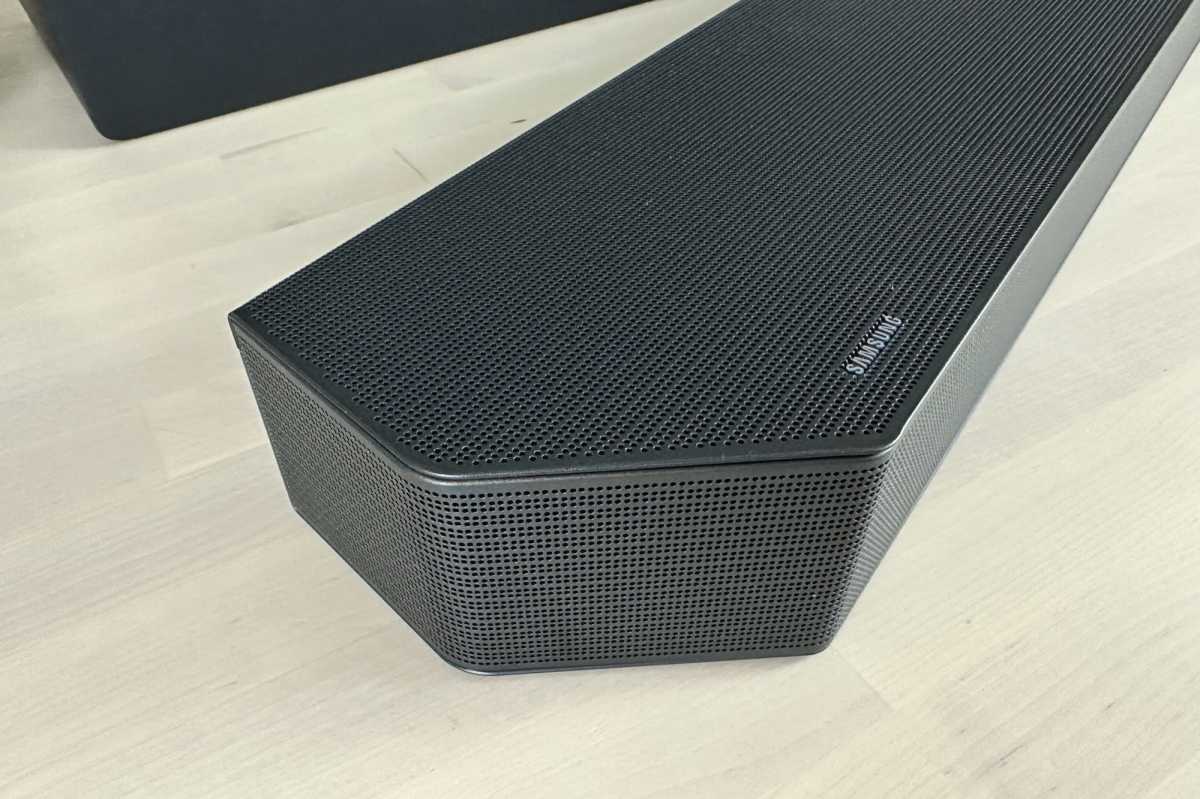
The left and right ends of the main HW-Q990C soundbar unit are angled for the side-firing drivers.
Ben Patterson/Foundry
Moving over to the UHD Blu-ray of Blade Runner 2049, the HW-Q990C smoothly handled the notoriously bassy intro to the film, gracefully delivering those lowest of low-frequency effects without heading into boomy territory. On the other side of the spectrum, the soundbar also excelled at the delicate atmospherics at the moisture farm, the precisely placed gurgle of the hot-water kettle in Sapper Morton’s otherwise dark and silent kitchen, and the soft putter of K’s drone as it floated overhead. Best of all, the sudden booms of K’s firearm in the deadly fight with Dave Bautista’s runaway replicant were big and deep, yet satisfyingly tight and controlled.
I also tried the 4K Blu Ray of Top Gun: Maverick, which offers the perfect Atmos demo as Mav’s Darkstar jet takes off directly above Admiral Kane’s head, shaking the ground and unsettling the roof of a nearby hut. It’s the perfect opportunity to hear height cues glide from the front upfiring drivers to the rear ones, and the Samsung delivers quite nicely. (The Darkstar’s deep engine roar in this sequence wasn’t as thrillingly deep as it was in IMAX, but I’ve noticed that across other home theater setups too, not just the HW-Q990C.) Even more impressive is when Maverick maneuvers his F-18 above Rooster’s in an inverted position, triggering a nearly silent boom that you feel more than hear. Cool.
Switching to music, I teed up a new recording of Rachmaninoff’s piano concertos performed by Yuja Wang, with Gustavo Dudamel conducting the Los Angeles Philharmonic. Appearing on the Deutsche Grammophon label in Dolby Atmos on Apple Music (I streamed the tracks on an Apply TV 4K), the performance sounded expansive yet focused on the Samsung HW-Q990C, with smooth, detailed sonics and big but natural-sounding dynamic changes–overall, an exciting yet nuanced experience that places you in (I’d say) row 10 of the orchestra section.
Changing gears to Taylor Swift, the effervescent “Willow” on Evermore (again in Dolby Atmos via an Apple TV 4K) sounded silky, delicate, and intimate, while the huge beats in Billie Eilish’s “Oxytocin” on Happier Than Ever didn’t overpower the HW-Q990C’s subwoofer. (Other soundbars I’ve tested do have issues with “Oxytocin,” often requiring careful fiddling with the low frequency levels to keep the bassline from overwhelming the track.) The non-Atmos “Alone Together” on Chet Baker’s Chet sounded atmospheric and detailed, although when upmixed in Adaptive mode, I felt like I was up on the stage, and not in a good way; this was a rare case when I preferred the Standard sound mode, which preserves the original 2.0-channel mix.
Price & availability
The Samsung HW-Q990C has a hefty $1,899.99 price tag, but if history is any guide, the soundbar will be frequently discounted–and indeed, it’s currently available on Samsung.com for $1,599.99, a $300 savings.
The HW-Q990C is also on sale at Amazon, Best Buy, B&H Photo, and other online retailers.
Should you buy a Samsung HW-Q990C soundbar?
For me, the Samsung HW-Q990C hits the sweet spot among the current crop of high-end soundbars. It delivers pleasing and immersive sound, easy setup, AirPlay 2 and Spotify Connect support, and room calibration, while Q-Symphony and Wireless Dolby Atmos are nice, if not must-have, bonuses for Samsung TV owners. (I used to get hung up on the fact that the HW-Q900C’s signature Q-Symphony required a Samsung TV, but the soundbar’s out-of-the-box performance is so good that I don’t really care anymore.) For these reasons, I’m naming the Samsung HW-Q990C our new Editor’s Choice for high-end soundbars.
Among its similarly priced competitors, the LG S95QR from 2022 (LG didn’t refresh its flagship soundbar this year) is right up there in the running, although its 9.1.5-channel configuration (which includes a center height channel, unique to LG) is a bit different than the HW-Q990C’s channel setup. The Sonos Arc is a terrific soundbar for those steeped in the Sonos ecosystem, but upgrading it with satellites and a subwoofer is a pricey proposition–and personally, the Arc’s sound is a little bright for my taste. The Sony HT-A5000 delivers exceptional sound too, but we thought it sounded boxy at times, and (as with the Sonos) upgrading it with additional speakers will cost you.




